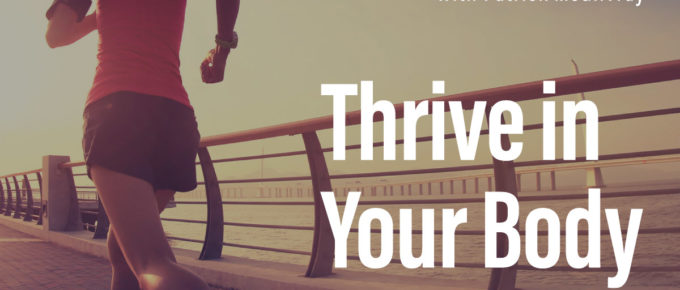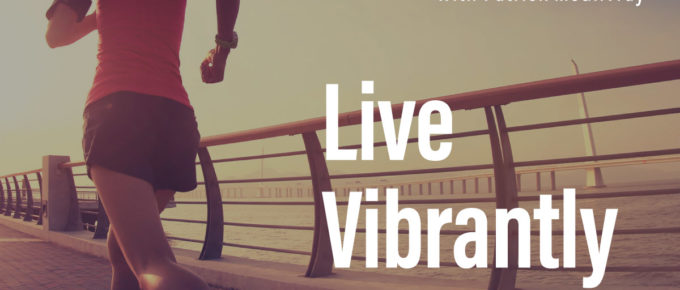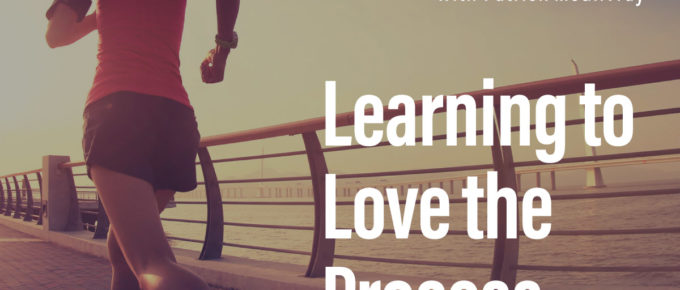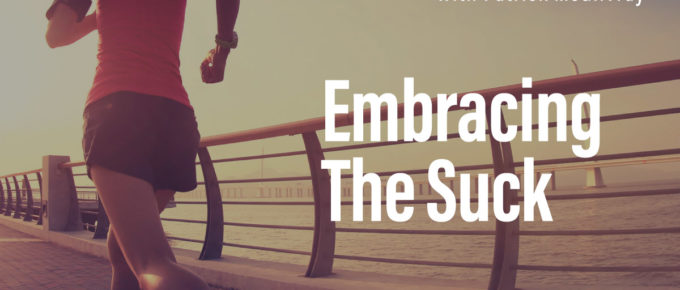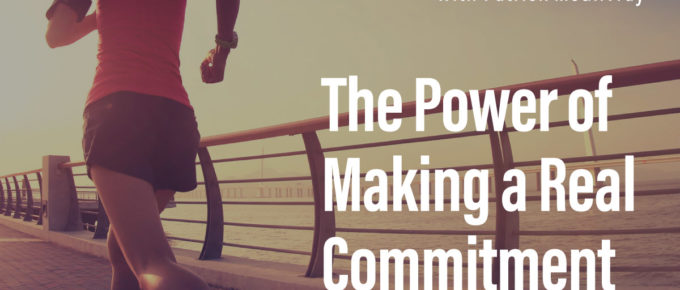I used to treat my body like a garbage dump. I ate a terrible diet, I smoked cigarettes, I drank way too much alcohol, and I never exercised at all. Then one day something happened that changed …
42. Thrive in Your Body
Podcast Transcript
My name is Patrick McGilvray. And I’m an experienced marathoner, ultra runner, Master Life Coach, and weight loss coach for runners. I’ve learned that running more and eating less does not work for weight loss, and that there’s a better way. Now I help runners like you to get leaner and get stronger, so you can run faster and run longer than you ever thought possible. This is Running Lean.
Hey there, and welcome to episode number 42 of Running Lean. My name is Patrick McGilvray, the weight loss coach for runners. And today I’m talking about how to thrive in your body. I used to treat my body kind of like a garbage dump. I ate a terrible diet, I smoked cigarettes, I drank way too much alcohol. And I never exercised at all.
And then one day, something happened to me that changed my whole outlook on life. And I made a decision to change everything, I decided to become the healthiest person that I could be. And through the years, I’ve tried, I haven’t done it perfectly. I’ve certainly made plenty of mistakes along the way.
But I’m here to tell you that you don’t have to settle for a miserable, unhealthy body, you can choose to thrive in that human body of yours. So in this episode of the podcast, I’m going to explain what it means to thrive in your body, and why it’s become one of my most important guiding principles.
But first, if you like this podcast, please come check us out on Facebook. Just search for the Running Lean community. It’s a positive, fun, energetic supportive group of like minded runners, it goes hand in hand with the podcast. We share our goals, we do weekly live coaching in the group.
And here’s a message from one of our amazing members, Nancy and she said, “I woke up this morning and got on the scale for the first time since I joined Patrick McGilvray on this journey a few months ago. And I’ve dropped 25 pounds. I’m not big about getting on the scales, but I could see some small changes, clothes fit a bit better. Necklaces laying nicer around my neck rings are falling off. And now I know why this is a big deal for me. I haven’t been this weight in over 10 years. And I’ve been running for five years. Thank you, Patrick for all you do. You’ve inspired me and taught me so much. And I can wholeheartedly say that I am a fat adapted runner. And I owe it all to you. I’m looking forward to continuing this journey with you. And all the great runners in this group hashtag you are a life changer.”
Nancy, that is such an amazing accomplishment. I am so proud of you. I’m proud of you because you’ve taken this information, and you’re applying it to your life. So it’s one thing to learn all these things, it’s quite another to apply these principles to your life. Super, super proud of you, Nancy, for doing the hard work.
So join us on Facebook, we have a lot of fun over there. Just search for Running Lean community. Also becoming a fat adapted runner, applying these principles to your life can be challenging. You know, developing the mindset that you need to make all of these healthy changes last permanently, can be hard work, it can be difficult to do on your own.
That’s why I offer one-on-one coaching. As a coach, I help you navigate all the information that’s out there around sports, nutrition, and diet and exercise and weight loss and all those other things and we put together a personalized plan that works for you. I hold you accountable for doing the work. I keep you on track, always moving in the direction of your goals.
I encourage you to do things you don’t want to do so that you can ultimately be who you want to be. You’ll develop the mindset required to make these changes stick for life. So if you’re ready to stop screwing around with all of this stuff, you’re ready to get serious and just change things. If you’re ready to begin to thrive in your body.
Then apply for one-on-one coaching with me. Just do it just go to innerfiretribe.com/weightlosscoaching, I promise you it will change your life.
Okay, let’s talk about this guiding principle today which is to thrive in your body. So a few months back, I put together the Running Lean manifesto. This is a list of guiding principles that I stand for, a list of things that help guide me. It’s like my North Star. And I’m sharing it with you because I want it to be our North Star. If we apply all of these principles to our lives, we can live the amazing, healthy, happy, vibrant life.
So a manifesto is just a list of guiding principles or a set of values to live by. A manifesto helps you to stay on track. It helps you to know where you are. Again, it’s like your Northstar, always guiding you towards your goals. Okay? These principles always guide me forward. I believe everybody should have a manifesto to live by.
And here’s the Running Lean manifesto. Number one is eat real food. Number two is to live vibrantly. Number three, which we’re talking about today thrive in your body. Number four, embrace discomfort, number five, run because you love it. Number six, love yourself unconditionally. Number seven, think, feel and act with purpose. And then number eight, to be an example of what’s possible.
So I’m going to be discussing each of these over the next few episodes of the podcast, taking a deep dive into each one. These principles guide everything that I do, every topic that I teach, can be tied back to one of these principles. I’m sharing this with you because I want this to be our, our collective guiding principles so that we can all move forward together, it’s a blueprint that we can all use to become the best version of ourselves.
Okay, so the third principle, and the one I’m talking about today is to thrive in your body. So what does it mean to thrive? The definition of thrive is to grow or develop well or vigorously to prosper, or flourish. So to thrive in your body means to grow or develop well or vigorously in your body, to prosper or flourish in your body.
And I think, correct me if I’m wrong, but I think this is our goal here, right? I don’t believe our goal should be to just get by, or survive. I believe our goal should be to thrive physically, our goal should be to thrive as human beings here on this planet. So I don’t think anybody’s going to argue with me on this one. I think most people would say that they are trying to do just that. That they are trying to thrive to try to be as healthy as possible.
I think most people strive to do and be more. But the reality might be very different. A lot of people might say they want to be healthy, but their actions really don’t support that. And I think a lot of people are stuck in this cycle of like, self-sabotage where they do things that undermine these goals of theirs.
But I want you to think about this for a minute. Think about how far we’ve come as human beings here on planet Earth. Okay, think about all of the things that could have gone wrong and did go wrong during our evolutionary period. Think about the long, slow process of natural selection.
And how we came out of that, as these thinking intelligent, creative humans. You know, think about the 100,000 years of the last ice age that we survived that we lived through as humans, we evolved through that.
Think about all the natural disasters we’ve survived. Think about how much we’ve endured as humans. And then what we’re just going to stuff our faces with sugar and drink ourselves into oblivion. Today, is this how we’re going to choose to live our lives filled with like, pain and stress and suffering and illness and disease?
Is that really how you want to choose to treat your body because it is a choice you get to choose. Choosing to thrive in your body is a choice you make every single day. You wake up in the morning and you get to decide how you’re going to treat your body today.
And of course, you’re gonna say, oh, I want to be healthy. We all say that. I believe we all want that to I think we all want to be healthy. Nobody wants to be sick or obese. Right? Nobody wants type two diabetes. But do you make the decision daily to do what it takes to thrive in your body? Do you commit to it every single day?
Because I’m going to tell you right now that that is exactly what it takes. It takes a daily commitment and then a recommitment. You get up and you said you’re gonna run but you don’t feel like it so you stay in bed. Or you said you’re not eating sugar but then someone at work left doughnuts in the break room and it’s just a doughnut, right?
And hey, they’re free. So you eat one or two, especially if they have those long johns with a maple icing on them. Those are my favorites. You know, you say you’re not going to do that, but you do. You know what to do, you know, you should choose running over sleeping in, that’s what you wanted to do.
You know, you should walk away without eating the maple covered doughnuts, but you don’t. And it’s in those moments that you’re choosing, you’re making a decision that your health is just not that important to you. It may not seem like a big deal in the moment. But keep putting that together, keep repeating the same cycle over and over again. And where do you get? Where does that get you?
So you’re deciding that 30 minutes of extra sleep is more important than your health or then running that half marathon that you said you wanted to train for. You’re deciding that this pile of fried flour and sugar is more important to you than losing the 10 pounds that you said was so important for you to lose.
You may not want to hear this. But I think you need to hear what I’m saying here. Whether you thrive in your body or not, it’s always a choice. It’s always a decision that you’re making. It’s always a choice you get to make. Now, of course there are some minor exceptions. And I’m not talking about debilitating genetic diseases, cancer and things that like you can’t choose.
Okay, so please, there will be some exceptions to this. But you know exactly what I’m hitting on here. Okay, I’m talking about deciding to create a physically healthy, thriving body. Okay. So a good example of this was like me some years back. My choices were literally like killing me. I was very overweight, I weighed about 230 pounds, so 70 pounds more than I weigh now.
And I was drinking a lot of alcohol. I was basically getting drunk every night. I was smoking a pack of cigarettes a day. And I had a lot of health problems. I was sick all the time. I was treating my body like a garbage dump. Every day, I was poisoning myself with food and with alcohol.
And you know, at the time, it just felt good. If I knew what I was doing, I knew that I was being unhealthy. But I would sort of make jokes about it. You know, even my friends and family would joke with me and say, oh, look, it’s fatty Patty from Cincinnati as a joke.
And I would sort of go along with it like, oh, yeah, that’s hilarious. But inside, I was like, I was literally dying. I was very self conscious about that. And it was really, it was eating and drinking was how I dealt with life.
And I ended up with a cancer diagnosis. That scared the crap out of me, honestly, it was so scary for me. I had two little kids at the time, and it just scared me straight. Basically, it scared me back to like I had to make a decision to do something. I did not want to die.
And I decided and this was back in like 2003 that I was no longer going to trash my body. I was no longer going to treat my body like a garbage dump. And then I was going to start taking care of myself and that I was going to thrive in my body because the alternative was to deteriorate, to continue to decay, to dwindle away to nothing.
And to live that way, was just no longer acceptable for me. So I made a decision: I chose to thrive in my body. I started eating better. I started running. I stopped smoking, I stopped drinking. And life just like perfect and easy and carefree after that. No, it was hard. I made a lot of mistakes. I had setbacks, I had failures. I was disappointed with myself. I suffered injuries. You know, I gained a bunch of that weight back over time. I tried stuff that worked. I tried stuff that didn’t work. I had some success, I had failures.
And then recently at the beginning of 2020, I re-committed to thriving. I decided once again that I was no longer going to treat my body like a garbage dump. I decided to stop tearing myself down because I became very addicted to carbohydrates and sugar.
And I’d started gaining weight again and I got close to 200 pounds again. I decided that I was going to do whatever it takes to become that healthiest version of myself yet. I made a decision to thrive in my body. And now I’m just telling you, I never want to go back to that person that I was that diseased, inflamed, unhealthy person, I created that body for myself.
And looking back on it, I’m like, what was I thinking? Especially like, smoking cigarettes, oh, my God, it’s terrible. So today, I focus on my future, that future version of myself that’s healthy, happy and thriving. And I want that for you, too. I want that so badly for you. I want you to choose to thrive in that one amazing human body that you have.
So forget the past, forget whatever you’ve done in the past, you are not your past. Your past does not determine your future. I want you to decide today that you want to thrive. And I want you to do something about it starting today. You know, I talk a lot about making decisions. I believe everything we want in our lives is created by a series of decisions.
Tony Robbins says I love this quote, he says, “It’s in your moments of decision that your destiny is shaped.” That is such a powerful quote, I quote this all the time, who you are today, this person that you are, this body that you have today, was created by a long series of decisions that you’ve made over the years, right? Ultimately, who you want to become is determined the exact same way.
Here’s the thing, a lot of people think life is just happening to them. Like it’s out of their hands out of their control. There’s nothing they can do about it, play the cards you’re dealt, it’s all predetermined. I think this is so disempowering, it means that you’re just a puppet. And like there’s some grand, you know, puppeteer, controlling your destiny.
I do not like this concept at all. I think it’s stupid. And I think it will get you absolutely nowhere. I want you to take back your power. I want you to start making decisions that serve you. And this goes for every aspect of your life. You know, not just your physical body, but in everything that you do.
I want you to choose to thrive. I want you to decide that you are going to thrive in this body. And I want you to recommit to that every single day. So what does it look like to thrive in your body? Well, let’s talk about this. It means your body is free from inflammation and illness and disease. It means you physically feel good in your body, it means you are strong and you are fit. It means you’re doing something daily to improve your overall health.
So you might walk, you might run, you might eat real food, you might build strength and endurance, you might work on a positive mindset, you might be taking control of your thoughts and feelings, all of these things is what it looks like to thrive in your body.
And when you focus on thriving, physically, everything in your everything else in your life tends to kind of fall into place naturally. So when you feel good in your body, you know you feel good in your mind. When you have a positive self image of your physical self, you have this positive mental state of mind.
You show up in a more positive way for your partner, for your kids, for your work, for your career, you begin to see better results in everything that you do in your life. I believe 100% that you are capable of so much more than you even realize. I believe you can create the exact body that you want for yourself.
How do you do it? Well, that’s exactly what you’ve been learning here in this podcast in the Facebook group. This is what I do with my coaching clients. Look at who it is you want to be and then decide to start working toward that version of yourself. You know, it’s different for everyone but you can start by eating real food.
You know, stop eating the sugar and refined carbs. I know there’s a lot of different ways you can change your diet to be more healthy. But I just encourage people to eat whole food, eat food that’s close to nature, unprocessed, right? Eat foods our ancestors would have eaten. And for a recap on this, listen to the episode on, Eat Real Food.
And that was our first principle, from the manifesto. You might choose to take a break from alcohol, that might be some way that you choose to thrive. You know, you don’t have to declare yourself an alcoholic or start going to 12 step meetings or, or whatever. But if you feel like you’re drinking too much, you can take a break.
And I work with my clients and I suggest as we begin their new nutrition plan that they may take a break from alcohol for 30 days or so and see how it goes. And if you want help with this, please reach out to me directly, I would love to help you with that.
Another way you might choose to thrive and your body is to start building strength. Decide that you want to build a stronger body, everyone can benefit from strength training, honestly, it doesn’t have to take a lot of time and effort to join a gym and like have a personal trainer on stuff, you can do it a couple times a week workout, lift some heavy things, do bodyweight exercises, use bands, whatever it takes.
But building lean muscle is one of the best things you can do for your overall health and fitness. You might choose to run more as a way of, you know committing to thriving in your body, you might want to run a half marathon or a full marathon or an ultra marathon, you might want to just start running three or four times a week, whatever that looks like for you make a decision, decide that this is important to you, and you’re going to do it.
I committed to running a marathon this month. So I’m running a marathon at the end of this month. And so I’ve been running more. And I’ve just committed to that process. And I have this vision of me crossing the quote unquote, finish line, virtual marathon, right? Whatever that finish line will look like. And I have this vision of myself crossing that virtual finish line. And I’m committed to making that happen. And I feel really good about that decision.
So what would it look like for you to thrive in your body? Think about how you can optimize your health and your fitness. There’s no right or wrong answer here. Do what feels good for you, do what feels right for you. But I want to encourage you, and I want to challenge you to do something to choose to thrive. You may want to just choose some kind of goal for yourself.
A good goal is something that you can measure. So you’ll know when you get there. Like I want to lose 20 pounds or I want to you know, maybe get off of this medication that I’ve been taking for whatever illness that you might have, you know, maybe you want to have more energy.
Maybe you want to be able to run three miles without stopping, you want to think more clearly, lift more weight, you want to be able to do like 10 pull dps. That’s a goal of mine, I want to be able to do 10 pull ups.
You might want to feel more at peace, have more calmness in your life, less stress. You may want to feel happier, like run an ultra marathon, whatever the goal is, make sure it’s tangible, so that you’ll know when you get there. So choose a goal. And then do something today to move toward that goal.
Challenge yourself, see what you’re capable of. Because you know what, you are an amazing, powerful, unique, capable human being you can do anything that you want. But first you have to decide that you want to thrive in that body. Decide that you are not going to settle, that you’re not going to just survive. You’re not going to just make do or subsist or just deal with it. You know or muddle through your life, miserably. Instead, decide that you are going to thrive in your body.
Focus on who you want to become that amazing, healthy future version of you. Focus on thriving and that amazing human body that you have. See what you’re physically capable of. Choose to thrive. Choose it every day. It’s a choice you have to make every day that when you do, you might just blow your own damn mind with who you become.
Okay, I’m going to be diving into all of the other principles from the Running Lean manifesto here in upcoming episodes, I’m really excited to share all this stuff with you. And we will be continuing this conversation over in the Running Lean community on Facebook, join us over there and you can start applying all of these guiding principles to your own life. That is all I have for you today. Lots and lots of love to each and every one of you, my friends, keep on Running Lean. I’ll talk to you soon.
If you’ve tried to lose weight by running miles and miles or starving yourself and you’ve had zero results, you are not alone. This model of weight loss is broken. It’s never worked, and it has to be replaced. That’s why I created a powerful new training just for you called How to Become a lien running machine. You’ll discover why running more and eating less does not work for weight loss and you’ll learn the three secrets to losing weight and keeping it off for good to get this free training right now just go to runningleanpodcast.com/lean and learn how you can become lean running machine.

